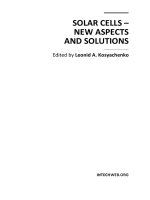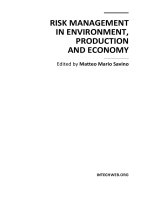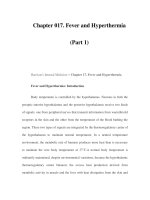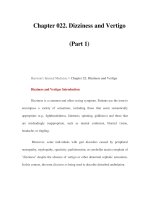Vascular neurology questions and answers - part 1 doc
Bạn đang xem bản rút gọn của tài liệu. Xem và tải ngay bản đầy đủ của tài liệu tại đây (473.09 KB, 34 trang )
Nancy Futrell, MD and Dara G. Jamieson, MD
The only review book for the largest subspecialty in neurology, Vascular Neurology:
Questions and Answers contains over 500 multiple-choice questions, each with an
answer, detailed explanation, and references for further review.
Vascular Neurology covers everything from the basics of neuroscience to “must-
know” clinical neurology to neurovascular specifics. It includes Board-formatted
review questions and is divided into nine key sections for targeted topic study.
Key features include:
• Over 500 Board-type questions and answers used throughout
• References for each question to further study
• In-depth coverage of all key topics for the vascular neurology subspecialty
examination
• Profusely illustrated with nearly 100 black & white and color images
• Applicability to a wide range of physicians, including medical students,
neurology residents, vascular neurologists, cardiologists, neurosurgeons,
internists, and hospitalists
Vascular Neurology: Questions and Answers is a must-have review tool for
anyone taking the vascular neurology subspecialty exam, the neurology Board
exam, and the Residency In-service Training Exam, and for any physician who
wants to review vascular neurology, test his or her skills, or better understand this
important topic. It is the most effective way to prepare for exams and assess
your knowledge of the field.
TOPICS:
Basic Science Pharmacology
Clinical Stroke Clinical Cardiology
Clinical Hematology Clinical Pediatrics
Imaging Clinical Pathology
Rehabilitation
Demos Medical Publishing
386 Park Avenue South
New York, NY 10016
www.demosmedpub.com
Vascular Neurology
Questions and Answeres
Futrell / Jamieson
Futrell 00.indd iFutrell 00.indd i 11/19/07 10:40:56 AM11/19/07 10:40:56 AM
Futrell 00.indd iiFutrell 00.indd ii 11/19/07 10:40:57 AM11/19/07 10:40:57 AM
Nancy Futrell, MD
Director
Intermountain Stroke Center
Salt Lake City, Utah
Dara G. Jamieson, MD
Associate Professor of Clinical Neurology
New York Presbyterian Hospital
Weill Medical College of Cornell University
New York, New York
Futrell 00.indd 0iiiFutrell 00.indd 0iii 11/19/07 10:40:57 AM11/19/07 10:40:57 AM
ACQUISITIONS EDITOR: R. Craig Percy
COVER DESIGN: A Good ing
COPYEDITOR: Joann Woy
COMPOSITOR: Patricia Wallenburg
PRINTER: Transcontinental Printing
Visit our website at www.demosmedpub.com
© 2008 Demos Medical Publishing, LLC. All rights reserved. is book is protected
by copyright. No part of it may be reproduced, stored in a retrieval system, or trans-
mitted in any form or by any means, electronic, mechanical, photocopying, record-
ing, or otherwise, without the prior written permission of the publisher.
LIBRARY OF CONGRESS CATALOGING-IN-PUBLICATION DATA
Futrell, Nancy.
Vascular neurology : questions and answers / Nancy Futrell, Dara G. Jamieson.
p. ; cm.
Includes bibliographical references and index.
ISBN-13: 978-1-933864-24-2 (pbk. : alk. paper)
ISBN-10: 1-933864-24-9 (pbk. : alk. paper)
1. Cerebrovascular disease—Examinations, questions, etc. 2. Neurology—
Examinations, questions, etc. I. Jamieson, Dara G. II. Title.
[DNLM: 1. Cerebrovascular Accident—Examination Questions. 2. Neurology—
Examination Questions. WL 18.2 F996v 2008]
RC388.5.F88 2008
616.8’10076—dc22
2007046823
Medicine is an ever-changing science undergoing continual development. Research
and clinical experience are continually expanding our knowledge, in particular our
knowledge of proper treatment and drug therapy. e authors, editors, and publisher
have made every eff ort to ensure that all information in this book is in accordance
with the state of knowledge at the time of production of the book.
Nevertheless, this does not imply or express any guarantee or responsibility on the
part of the authors, editors, or publisher with respect to any dosage instructions and
forms of application stated in the book. Every reader should examine carefully the
package inserts accompanying each drug and check with a his physician or specialist
whether the dosage schedules mentioned therein or the contraindications stated by
the manufacturer diff er from the statements made in this book. Such examination is
particularly important with drugs that are either rarely used or have been newly re-
leased on the market. Every dosage schedule or every form of application used is en-
tirely at the reader’s own risk and responsibility. e editors and publisher welcome
any reader to report to the publisher any discrepancies or inaccuracies noticed.
Special discounts on bulk quantities of Demos Medical Publishing books are avail-
able to corporations, professional associations, pharmaceutical companies, health
care organizations, and other qualifying groups. For details, please contact:
Special Sales Department
Demos Medical Publishing
386 Park Avenue South, Suite 301
New York, NY 10016
Phone: 800–532–8663 or 212–683–0072
Fax: 212–683–0118
Email:
MADE IN THE UNITED STATES OF AMERICA
08 09 10 5 4 3 2 1
Futrell 00.indd 0ivFutrell 00.indd 0iv 11/19/07 10:40:57 AM11/19/07 10:40:57 AM
Preface vii
Acknowledgme nts xi
1 Basic Science 1
2 Pharmacology 13
3 Clinical Stroke 60
4 Clinical Cardiology 161
5 Clinical Hematology 181
6 Clinical Pediatrics 194
7 Imaging 209
8 Clinical Pathology 255
9 Rehabilitation 269
References 283
Abbreviations 307
Futrell 00.indd 0vFutrell 00.indd 0v 11/19/07 10:40:57 AM11/19/07 10:40:57 AM
Futrell 00.indd 0viFutrell 00.indd 0vi 11/19/07 10:40:57 AM11/19/07 10:40:57 AM
S
TROKE IS THE THIRD MOST COMMON CAUSE of death
and disability in the US. It is a complex disease, with many
causes, many presentations, and many levels of severity. De-
spite recent medical advances, stroke remains a diffi cult disease
to diagnose and treat. In recognition of the importance of this
common disorder, the American Board of Psychiatry and Neu-
rology (ABPN) instituted a new subspecialty examination in
2005. According to the ABPN’s website, this exam is intended
“to offi cially establish the fi eld of vascular neurology as a defi -
nite area of subspecialization in neurology and child neurology
and to provide a means of identifying properly trained and ex-
perienced vascular neurologists.”
Vascular Neurology: Questions and Answers, is intended to
be a comprehensive study guide for the ABPN’s vascular neu-
rology subspecialty exam. In addition, this book can be used by
any physician who wants to thoroughly and systematically re-
view the topic of vascular neurology, self-assess his or her skills,
or prepare for another examination that contains questions on
this important topic.
While the ABPN’s exam consists of 200 multiple-choice
questions administered during a 4-hour period, Vascular Neu-
rology: Questions and Answers contains over 500 multiple-
Futrell 00.indd 0viiFutrell 00.indd 0vii 11/19/07 10:40:57 AM11/19/07 10:40:57 AM
choice questions, each with an answer, detailed explanation,
and one or more references for further study and review as de-
sired. We have included almost 100 illustrations (some in full
color) keyed to many of the questions. e book is divided into
chapters with questions providing detailed coverage of basic
science, pharmacology, clinical stroke, hematology, cardiology,
pediatrics, neuroimaging, neuropathology, and rehabilitation.
All of these topics are important components to an in-depth
understanding of the fi eld, and all are important components of
the ABPN’s vascular neurology subspecialty examination.
ose readers who are preparing for the ABPN’s exam are
strongly encouraged to visit the ABPN website for informa-
tion about, and requirements for, the exam: www.abpn.org. It
is important to note that there will be a “grandfathering period”
through 2009. During this time, Board-certifi ed neurologists
may apply to take the exam if they can provide documentation
that they have “a minimum of 25% of practice time devoted to
vascular neurology.” After 2009, all applicants will need to have
successfully completed a 1-year vascular neurology fellowship
program.
Stroke is a topic of critical relevance to neurologists, cardi-
ologists, emergency room physicians, internists, vascular and
neurosurgeons, and physiatrists worldwide. While not intend-
ed to be an authoritative reference source, Vascular Neurology:
Questions and Answers will provide these professionals with an
excellent (and fun) resource that will enable them to test their
knowledge, clinical skills, and exam-readiness in a relatively
short period of time.
As with any book, the authors may learn the most. Devel-
oping questions in areas outside of neurology required gain-
ing a higher level of understanding in some areas, such as fetal
development of the heart and perinatal changes in circulation.
e questions and answers contained in this book are designed
to synthesize complex information into an easily understood
format. As we wrote this book, each of us developed half of the
questions and the other did a self-test with these questions. We
found approaching the questions as a test, while comparing our
viii PREFACE
Futrell 00.indd 0viiiFutrell 00.indd 0viii 11/19/07 10:40:57 AM11/19/07 10:40:57 AM
answers with the correct answer, was fun and informative. We
hope our readers will have the same experience.
For those using this book to prepare for the ABPN’s vascu-
lar neurology subspecialty exam, we wish you luck. For those
using this book as a means of better understanding this impor-
tant topic, we wish you happy reading and learning.
Nancy Futrell, MD
Salt Lake City, Utah
Dara G. Jamieson, MD
New York, New York
PREFACE ix
Futrell 00.indd 0ixFutrell 00.indd 0ix 11/19/07 10:40:58 AM11/19/07 10:40:58 AM
Futrell 00.indd 0xFutrell 00.indd 0x 11/19/07 10:40:58 AM11/19/07 10:40:58 AM
THE AUTHORS WISH TO THANK:
Ehud Lavi, MD, my husband, who encouraged me in the writ-
ing of this book and provided the neuropathology pictures.
— DJ
Clark Millikan, MD, my spouse and mentor in vascular neurol-
ogy. e recognition of vascular neurology as a board certifi ed
specialty is the culmination of his lifetime work in establishing
this fi eld.
— NF
We would also like to thank NeuroLogica Corporation, Dan-
vers, Massachusetts, for their generosity in making the color
prints possible.
Futrell 00.indd 0xiFutrell 00.indd 0xi 11/19/07 10:40:58 AM11/19/07 10:40:58 AM
Futrell 00.indd 0xiiFutrell 00.indd 0xii 11/19/07 10:40:58 AM11/19/07 10:40:58 AM
Futrell 00.indd 0xiiiFutrell 00.indd 0xiii 11/19/07 10:40:58 AM11/19/07 10:40:58 AM
Futrell 00.indd 0xivFutrell 00.indd 0xiv 11/19/07 10:40:58 AM11/19/07 10:40:58 AM
1. e atherogenicity of lipoproteins is related to size. Which of the following
statements is true?
A. e largest lipoproteins are the most atherogenic.
B. e smallest lipoproteins are the most atherogenic.
C. e intermediate sized lipoproteins are the most atherogenic.
D. e large- and intermediate-sized lipoproteins are most atherogenic.
E. e intermediate- and small-sized lipoproteins are most atherogenic.
2. e intimal layer of arteries is lined with endothelial cells and also contains:
A. Smooth muscle cells in humans and rodents.
B. Smooth muscle cells in humans, but not in rodents.
C. Extracellular matrix, but no smooth muscle cells in humans or animals.
D. Adipose cells.
E. T cells.
3. Which of the following substances is atherogenic?
A. Tissue factor.
B. Interferon-γ.
C. CD4
+
T cells.
D. Heat shock proteins.
E. All of the above.
4. Intimal thickening at arterial bifurcations:
A. Is present at birth.
B. Is present in infancy and childhood only in individuals at high risk for the
development of diff use atherosclerosis during adulthood.
C. Develops shortly after puberty.
D. Develops in early adulthood.
E. Develops in middle adulthood.
Futrell 01.indd 1Futrell 01.indd 1 11/19/07 11:06:16 AM11/19/07 11:06:16 AM
2 BASIC SCIENCE: QUESTIONS
5. Fatty streaks in arteries:
A. Do not develop in the fetus.
B. Can be seen in the aorta in children.
C. Are composed of extracellular lipids.
D. Form most often in individuals who will eventually develop signifi cant
atherosclerosis.
6. e main regulator of blood pressure is:
A. e sympathetic nervous system.
B. e parasympathetic nervous system.
C. e kidneys.
D. e adrenal gland.
7. Which of the following contributes to elevated blood pressure?
A. Vasopressin.
B. Renal sympathectomy.
C. Atrial natriuretic peptide.
D. e parasympathetic nervous system.
8. e artery of Percheron:
A. Arises from the distal basilar artery.
B. Supplies the cerebellar peduncle.
C. When occluded, results in bilateral thalamic/midbrain infarcts.
D. Is a vestigial remnant seen in 1% of cerebral arteriograms.
9. Nitric oxide (NO):
A. Raises blood pressure.
B. Lowers blood pressure.
C. Has variable eff ects on blood pressure.
D. Has no eff ect on blood pressure.
10. Shear stress causes:
A. Stretching injury of the vessel.
B. Alignment of endothelial cells along the linear axis of the laminar fl ow.
C. Decreased release of NO.
D. Increased superoxide levels.
Futrell 01.indd 2Futrell 01.indd 2 11/19/07 11:06:17 AM11/19/07 11:06:17 AM
BASIC SCIENCE: QUESTIONS 3
11. Vascular smooth muscle hypertrophy is stimulated by:
A. Mechanical vascular injury.
B. Platelet-derived growth factor.
C. Angiotensin II.
D. Fibroblast-derived growth factor (FDGF).
12. Vascular smooth muscle hyperplasia is stimulated by:
A. Hypertension.
B. rombin.
C. Angiotensin II.
D. Infl ammatory cytokines.
13. Which statement best describes apolipoprotein A-1 (apoA-1)?
A. Elevated levels of apoA-1 may indicate vascular risk in women.
B. ApoA-1 comprises about 70% of the total protein mass of high-density
lipoprotein (HDL).
C. ApoA-1 plays a minimal role in reverse cholesterol transport.
D. ApoA-1 is a less accurate predictor of vascular risk than is HDL.
E. ApoA-1 levels must be measured after fasting leading to variable and
poorly standardized results.
14. When decreased cerebral perfusion causes autoregulatory failure, what hap-
pens to each of the following parameters? Each response may be used more than
once.
A. Cerebral blood fl ow (CBF). 1. Increased.
B. Cerebral blood volume (CBV). 2. Decreased.
C. Mean transit time (MTT). 3. Unchanged.
D. Oxygen extraction fraction (OEF).
E. Cerebral metabolic rate of O
2
(CMRO
2
).
15. Lipoprotein-associated phospholipase A2 (Lp-PL A2):
A. Is an enzyme that is secreted by macrophages, T lymphocytes, and mast
cells.
B. Is primarily bound to HDL and very low-density lipoprotein (VLDL).
C. Should be assayed routinely to dictate patient management and vascular
risk reduction.
D. Is a risk factor for cardiovascular disease that is dependent on diabetes.
E. All of the above.
Futrell 01.indd 3Futrell 01.indd 3 11/19/07 11:06:17 AM11/19/07 11:06:17 AM
4 BASIC SCIENCE: QUESTIONS
16. Which of the following usually mediates neuronal apoptosis (programmed
cell death) in brain ischemia?
A. Cysteine-requiring aspartate-directed proteases (caspases).
B. Apoptosis-inducing factor (AIF).
C. Endonucleases.
D. Matrix metalloproteinases (MMPs).
E. Bradykinin.
17. Vascular endothelial growth factor (VEGF):
A. Aff ects blood vessels but not neurons or glial cells and plays no role in
neurogenesis.
B. Has no role in diseases of the peripheral nervous system.
C. Is induced by hypoxia through hypoxia-inducible factor (HIF-1) transcrip-
tion factor.
D. Promotes angiogenesis, the diff erentiation of angioblasts into endothelial
cells to form de novo blood vessels.
E. Has a deleterious eff ect on recovery from cerebral ischemia.
18. Match the level of cerebral blood fl ow to the cellular events:
A. 35–25 mL/100 g/min. 1. Electrical failure.
B. 18–25 mL/100 g/min. 2. Deterioration of transmembrane
C. 50–55 mL/100 g/min. ionic gradients.
D. < 10–12 mL/100 g/min. 3. Homeostasis.
4. Increased glycolysis.
19. Which of the following statements best describes the role of glutamate in
cerebral ischemia?
A. Glutamate is released into the extracellular space with an rCBF of 10% of
normal (<5 mL/100 g/min).
B. Antagonism of glutamate receptors in animal models of ischemia has
translated into effi cacy in human neuroprotection.
C. Glutamate may mediate anoxic and hypoglycemic hippocampal and cor-
tical neuronal injury.
D. Ischemia results in the release of glutamate, which activates ligand-gated
calcium (Ca
2+
) channels in presynaptic neurons.
Futrell 01.indd 4Futrell 01.indd 4 11/19/07 11:06:17 AM11/19/07 11:06:17 AM
BASIC SCIENCE: QUESTIONS 5
20. Endothelial cells produce:
A. Anticoagulant and thrombolytic substances, but no prothrombotic sub-
stances.
B. Anticoagulant, thrombolytic, and prothrombotic substances.
C. Only thrombolytic substances, with no anticoagulant or prothrombotic
substances.
D. Anticoagulant substances, with no thrombolytic or prothrombotic sub-
stances.
21. Nitric oxide:
A. Is a byproduct of -arginine.
B. Release is decreased by shear stress.
C. Production is decreased by exercise.
D. Produces vasoconstriction.
22. e posterior spinal artery generally branches from which artery?
A. Vertebral artery.
B. Basilar artery.
C. Posterior inferior cerebellar artery.
D. Anterior inferior cerebellar artery.
23. Which cranial nerve exits the brainstem between the posterior cerebral ar-
tery and the superior cerebellar artery?
A. Nerve III.
B. Nerve IV.
C. Nerve V.
D. Nerve VI.
24. Lipoprotein(a):
A. Consists of apolipoprotein(a) covalently linked to apolipoprotein B-100.
B. May be involved in thrombolysis based on the apoB-100 moiety.
C. Diff ers from low-density lipoprotein (LDL) cholesterol LDL-C by the apoB-
100 component.
D. Has little role in the pathogenesis of cerebrovascular disease.
Futrell 01.indd 5Futrell 01.indd 5 11/19/07 11:06:17 AM11/19/07 11:06:17 AM
6 BASIC SCIENCE: QUESTIONS
25. e labyrinthine artery most frequently originates from which artery?
A. Basilar artery.
B. Anterior inferior cerebellar artery.
C. Superior cerebellar artery.
D. Posterior inferior cerebellar artery.
E. Posterior cerebral artery.
26. Which infectious agent is most closely associated with atherosclerosis?
A. Chlamydia pneumoniae.
B. Helicobacter pylori.
C. Cytomegalovirus (CMV).
D. Mycoplasma pneumoniae.
E. Human immunodefi ciency virus (HIV).
27. Which one of the following decreases blood pressure?
A. Aldosterone.
B. Endothelin.
C. Angiotensin II.
D. Atrial natriuretic peptide.
Futrell 01.indd 6Futrell 01.indd 6 11/19/07 11:06:17 AM11/19/07 11:06:17 AM
1. e answer is C. Very low-density lipoprotein (VLDL) and chylomicrons are
the largest lipoproteins. ese are too large to enter the vessel wall, so they are
not atherogenic. High-density lipoprotein (HDL) are small lipoproteins that can
both enter and leave the blood vessel wall. us, HDL does not accumulate in
the vessel wall. ey may also serve a role in transporting cholesterol out of the
vessel wall, although the exact mechanism of protection by HDL is not known.
Low-density lipoprotein (LDL) is the major cholesterol-containing lipoprotein. It
can enter the vessel wall, but high LDL levels reduce the effl ux of cholesterol from
the vessel wall. (Strandness, Chapter 9)
2. e answer is B. Smooth muscle cells proliferate in the formation of ath-
erosclerosis. In humans, smooth muscle cells are present in the intima (although
most are in the media), but smooth muscle cells are not found in the intima in
rodents and many other animals. is is one of several diff erences in the vessel
wall that have added to the diffi culty in developing animal models of human ath-
erosclerosis. Neither adipose cells nor T cells are normally found in the intimal
layer of arteries. (Fuster, Chapter 44)
3. e answer is E. Heat shock proteins induce cytotoxicity in T cells, which
in turn induces tissue factor production in macrophages. T cells also produce
the infl ammatory cytokine interferon-γ. is is part of the cascade that induces
atherosclerosis. (Stoll et al., Stroke 2006)
4. e answer is A. Intimal thickening is present at birth in atherosclerosis-
prone locations, such as bifurcations. Atherosclerosis will form fi rst in such ar-
eas, but atherosclerotic plaque formation is not limited to these areas. (Fuster,
Chapter 44)
Futrell 01.indd 7Futrell 01.indd 7 11/19/07 11:06:17 AM11/19/07 11:06:17 AM
8 BASIC SCIENCE: ANSWERS
5. e answer is B. Fatty streaks can develop in the fetus, particular if the
mother has hypercholesterolemia. e lipids in fatty streaks are generally intra-
cellular, found mainly in lipid-fi lled macrophages (foam cells). Extracellular lipids
are present in atherosclerotic plaques but not in the fatty streaks. e relationship
between fatty streaks and the eventual development of atherosclerosis is inconsis-
tent. Although fatty streaks form in areas that are prone to atherosclerosis, their
development in various patient populations does not necessarily correlate with
the risk of atherosclerosis. For example, fatty streaks occur in women at younger
ages than in men, even though men develop atherosclerosis earlier than women.
Early in life, fatty streaks are more common in the thoracic aorta but, later in life,
atherosclerosis is more prominent in the abdominal aorta. (Fuster, Chapter 44)
6. e answer is C. e sympathetic nervous system elevates blood pressure,
particularly in situations of stress. e parasympathetic system responds to el-
evated blood pressure and mediates the production of substances to lower blood
pressure. In the long run, however, the kidneys have the main responsibility of
controlling blood pressure and blood volume. (Fuster, Chapter 61)
7. e answer is A. Vasopressin does not cause essential hypertension, but it
does contribute to the maintenance of elevated blood pressure in hypertensive
patients, particularly African Americans. In this population, the inhibition of va-
sopressin receptors decreases blood pressure. Renal sympathectomy lowers blood
pressure in experimental models of hypertension. Atrial natriuretic peptide is a
vasodilator that lowers blood pressure. e parasympathetic nervous system acts
to lower blood pressure. (Fuster, Chapter 61)
8. e answer is C. e central artery of Percheron arises from the fi rst seg-
ment of one of the posterior cerebral arteries, giving rise to bilateral medial
thalamic perforators. When occlusion produces bilateral paramedian thalamic
infarcts, the patient may present with alteration in consciousness and eye-move-
ment abnormalities. is artery is one of the few examples of a cerebral artery
that supplies a bilateral structure. (Raphaeli, et al. Neurology 2006)
9. e answer is C. Nitric oxide (NO) plays an important role in maintaining
appropriate blood pressure. It is a vasodilator and is produced by the endotheli-
um in response to vasoconstricting substances. In this setting, it counterbalances
forces that would produce hypertension. In individuals with insulin resistance,
however, NO plays a major role in the production of hypertension. (Fuster, Chap-
ter 61)
Futrell 01.indd 8Futrell 01.indd 8 11/19/07 11:06:17 AM11/19/07 11:06:17 AM
BASIC SCIENCE: ANSWERS 9
10. e answer is B. Shear stress is protective against atherosclerosis, and
stretching injury is detrimental. e major cause of stretching injury is hyper-
tension. Shear stress, associated with laminar fl ow, is particularly low at branch
points and vascular curvatures. Bifurcations, tortuous vessels, and kinks in ves-
sels are associated with turbulent fl ow, rather than laminar fl ow, and are at higher
risk for the formation of atherosclerotic plaques. Laminar fl ow causes an align-
ment of cells along the linear axis of blood fl ow. It increases the release of NO
and prostacyclin, which are protective against atherosclerosis. Stretching injury
causes increased superoxide levels, which increase the formation of atheroscle-
rotic plaques. (Fuster, Chapter 7)
11. e answer is C. Smooth muscle in vessels has two mechanisms of growth—
hypertrophy and hyperplasia. Hypertrophy refers to an increase in the size of the
smooth muscle cells. Angiotensin II promotes hypertrophy. e other answers
refer to factors that promote hyperplasia of vascular smooth muscle. (Fuster,
Chapter 7; Geisterfer et al., Circulation Res 1988)
12. e answer is D. Smooth muscle cells can undergo hypertrophy (enlarge-
ment of individual cells) or hyperplasia (cellular proliferation). Growth factors
produced following vascular injury are strong stimulants of smooth muscle hy-
perplasia, an important mechanism of restenosis following endarterectomy or
angioplasty. Infl ammatory cytokines contribute to smooth muscle hyperplasia.
e role of infl ammation is a major topic of investigation in the pathogenesis of
atherosclerosis. e other three answers refer to stimuli for smooth muscle hy-
pertrophy. (Fuster, Chapter 7; Dussailant, et al., J Am Coll Cardiol 1995)
13. e answer is B. ApoA-1 comprises about 70% of the total protein mass of
HDL. It is involved in the transport of phospholipids and unesterifi ed cholesterol
from peripheral cells to be converted to HDL, thus providing HDL with a core of
cholesterol esters and facilitating cholesterol excretion into bile. Lower levels of
apoA-1 appear to be more predictive of vascular risk than low HDL levels. Auto-
mated measurement of ApoA-1 can be carried out on nonfasting blood samples
with reproducible and standardized results. (Khuseyinova & Keonig, Curr Ath-
erosclerosis Rep 2006)
14. e answers are A 2, B 1, C 1, D 1, E 3. With decreased cerebral perfusion
pressure, cerebral blood fl ow (CBF) is stable over a wide range of pressure owing to
vascular autoregulation. Increases in mean arterial pressure (MAP)—an estimate
of cerebral perfusion pressure—produce vasoconstriction and increased vascular
resistance, thus maintaining CBF in a normal range. With decreased MAP, CBF
Futrell 01.indd 9Futrell 01.indd 9 11/19/07 11:06:17 AM11/19/07 11:06:17 AM









